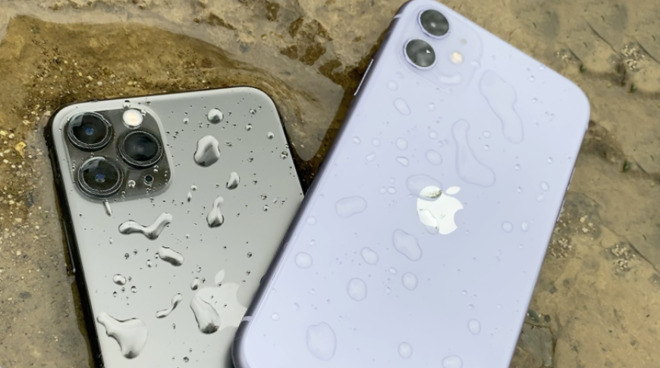The same people who have consistently failed to comprehend Apple’s business model over the last few decades are now postulating that COVID-19’s economic devastation will make Apple’s products broadly unaffordable on a global level.
Prior to examining how Apple as a company is performing under the incredible pressures of 2020’s pandemic circumstances, take a look at where the company was just as the COVID-19 epidemic began. Apple was clearly not on the ‘perilous edge of near doom’ that so many media bloggers were insisting that it was.
The Services “pivot” that didn’t happen in 2019
Just over a year ago, Apple threw a Tim Cook event at its Steve Jobs Theater, unveiling a series of new products that were neither purely hardware nor software, but classified as “Services.”
Because it appeared that iPhones were no longer able to maintain their historical unit growth, tech media columnists largely latched onto the narrative that the company was desperately falling behind in hardware and was now “pivoting, in a strategy reversal” to subscription content, supposedly following the lead of Netflix, Spotify, and other media darlings that make very little money. This was not even remotely true.
How could Apple possibly replace its iPhone cash machine with a handful of new Services such as Arcade, TV+, News+, and a new Apple Card, none of which appeared capable of generating massive revenues? It all sounded very troubling and ominous.
The reality, of course, was that Apple wasn’t “pivoting away” from anything; it was merely strengthening its relationship with its installed base of customers in order to ensure their repeat business when buying new hardware. This was obvious because Apple has long done the same thing using software, including its Pro Apps and iWork titles, and with hardware products like Apple Watch, which help to ensure that iPhone users remain iPhone users in the future.
Sure enough, Services turned out to be an effort in how to make the Apple ecosystem sticker. Rather than being a “pivot,” the new Services were merely a continuation of Apple’s “Walled Garden” of iTunes, Pro Apps, the App Store, and its more recent offerings of iCloud and Apple Music, each of which has increasingly cultivated a “paradise ecosystem” largely protected from malware scams, atrocious privacy violations, and wild lapses in security updates, although certainly not without flaws and controversy.
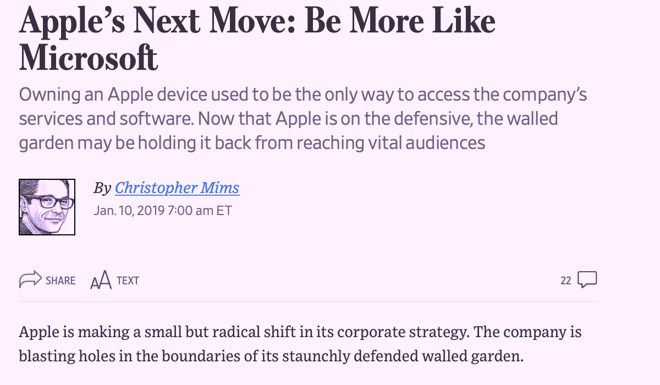
The WSJ incredibly imagined that Apple’s Walled Garden was the problem and needed “blasting”
Apple isn’t focused on selling the wall itself; it sells the experience inside the wall. Apple now has a billion customers who voluntarily choose to largely remain inside that wall, not because they can’t leave, but because Apple’s curated experience has given them good reasons to stick around.
It just so happened that Apple’s “Walled Garden,” despite being initially intended to run as “revenue neutral,” ended up generating significant revenues on its own, with operating margins that were higher than Apple’s hardware.
Location, location, location: Apple’s Walled Garden
Apple’s most cynical critics initially invented and promoted the term “Walled Garden” for iTunes and the App Store as a disparaging way to suggest that Apple was “locking in” consumers so they won’t want to leave to buy cheaper hardware from cloners.
That was technically true, but only in the sense that its also true that luxury resorts build fancy poolside bars and book DJs and performers to entertain their guests so they will show up and pay to enjoy the experience, rather than staying at home and saving all that money drinking $3 beers at the seedy bowling alley down the street that gets shut down by the health department every few months, frequented by some shady people who are looking to steal your wallet.
You can dramatically compare the price of a drink on either side of that “Walled Garden,” but without considering the overall experience you’re getting—and the risks that come with settling for cheap—that price differential itself isn’t very meaningful, and for most people, not even relevant in their decision making.
As with real estate, while price is important, location is paramount. Apple’s Walled Garden is, in effect, a desirable location for consumers who want to use apps, play games, and enjoy other content without worrying about being spied on, tracked, or otherwise harmed by uncurated markets teeming with malware, data collection ploys, unanticipated privacy violations, or even just the nuisance of wading through adware and fake apps that pretend to be something they are not.
Apple’s “location” of the App Store, Apple Music, Arcade, TV+ and other Services are not by any means perfect or completely free from any legitimate complaints. But compared to the Wild West free-for-all represented by Android stores and the once-vaunted notion of permissive side-loading of apps from any source, or the tumbleweeds of Windows Mobile 10, or Huawei’s market lacking essential Google apps, Apple’s ecosystem is an extremely desirable, exclusive prime location for mainstream users to invest in.
Experience is worth more than money
Just as the initial mainstream reports of a novel coronavirus began to surface at the beginning of this year, Apple’s Walled Garden of Services was finally being recognized and appreciated by investors. Even the slower, trailing edge of the tech media was beginning to understand this, after having such a hard time grasping that Services not only supported Apple’s hardware but was becoming a significant source of high margin revenues on its own, something Cook first began stressing five years earlier in 2014.
It took about as long for many tech media columnists to similarly absorb the reality that Apple’s premium-priced iPad was defining the tablet market and reshaping the PC industry, and wasn’t effectively being undercut or shoved out of relevance by lower-priced Android tablets no matter how cheap they got. Consumers weren’t just shopping for low prices, they were looking at the overall experience.
Across the heyday of the Windows PC from 1995 to 2010, it was broadly accepted that most consumers were really only shopping for computers based on price. While it was true that cheaper price tiers of Windows PCs hurt the sales of Apple’s more expensive Macs, it was also true that there were also much cheaper PC alternatives that didn’t run Windows that consumers simply weren’t buying, despite being significantly less expensive.
Many of the same people who struggle to understand why consumers have been buying iPhones and iPads when there are much cheaper Androids available were just as puzzled at why consumers a decade or two ago were buying Windows PCs rather than less expensive Linux PCs. But the reason was the same: buyers found that the overall experience was worth paying a premium to achieve.
The fans of Linux who migrated to Android are similarly convinced that once consumers recognize the difference in price, the market for Apple’s premium hardware will collapse–and that any economic downturn will hasten that. But these same columnists have long revealed that their theories are based on myopic, ideological tech enthusiast hopes and not any reflection of what consumers are actually doing.
When Bloomberg repeats that Androids ‘are now cheaper and quite serviceable’ as its logic for predicting a wave of defections from iPhones to new devices from Huawei and Samsung, it’s not because that is actually happening. It’s simply a hope that keeps repeating itself, removed from any understanding of why people buy things at all. For a large part, that’s because these writers have never directly produced or sold a valuable product, and simply have no frame of reference outside of a juvenile understanding that people shop based on price alone.
That’s simply not true, particularly as you rise along the economic ladder. The more luxurious the experience delivered, the less price matters.
Yet the full-on delusion of price centric buying does not square with the fact that Apple has been selling virtually all of the premium tech devices capable of being sold at a sustainable profit. Across the last year, Apple’s hardware business simply wasn’t in the desperate straits that these blogger-critics imagined.
The company wasn’t blindingly leaping off a burning platform into the choppy waters of Services that don’t make tremendous amounts of money.
Instead, Apple’s 2019 doubled down on the company’s historical strategy of hardware offerings sold within the Walled Garden of its ecosystem with the blockbuster releases of AirPods Pro, Apple Watch Series 5, iPhone 11, and the luxuriously-priced new 16 inch MacBook Pro—all racking up another record quarter just before the crisis of a global coronavirus pandemic hit.
Apple isn’t just a hardware company
Last year’s erroneous idea of a “Services pivot” that echoed among various prominent bloggers got Apple entirely wrong, but their previous narrative was also incorrect. Before jumping on the “pivot from hardware” bandwagon, the best way to get other tech bloggers to nod along in agreement with you was to repeat that Apple’s hardware business was basically a film studio that produced hit movies.
If it were ever to release one or two bad productions, the whole thing would begin to fall apart and implode into oblivion. At least that was the theory, or you might say, fantasy.
That ended up also being proven false. Apple has a long history of releasing weak or poorly launched products that didn’t remain in production very long, from Steve Jobs’ G4 Cube, Xserve, and iPod HiFi to Tim Cook’s well, most of Apple’s recent deliveries have been billion-dollar blockbusters, even if they haven’t eclipsed iPhone unit sales. But we’ve seen various new Mac and iPad launches that were merely ok, rather than being show-stopping milestones in the history of tech. The show still went on.
iPhone has long been the “blockbuster of blockbusters,” but Apple has released several generations that weren’t super exciting. It might be hard to recall, but Jobs’ iPhone 3G and 3GS were iterative advances, and the last iPhone 4S model he saw ship struggled to remain technically competitive with its Android peers, many of which had already moved forward to deliver larger screens, fancier cameras, and support for new 4G LTE networks years before Apple did, at prices that were notably cheaper.
What the product did have was a superior experience, delivered with iTunes, the App Store library, and Apple’s new Siri.
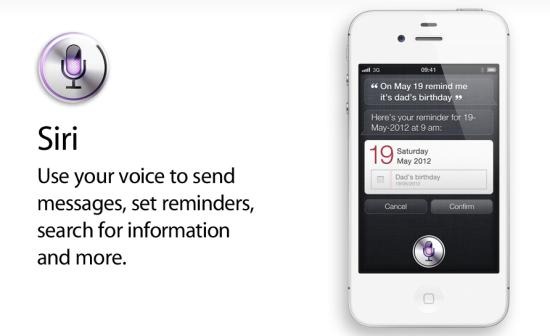
Apple’s overall experience beat Android cheap pricing and novel features
Pundits at the time began predicting that Apple couldn’t survive without cheap iPhone pricing in the range of around $300, but they were fantastically wrong. Apple’s pricing instead incrementally notched up. But it certainly wasn’t higher prices that were drawing new customers into the Walled Garden.
It was an increasingly appealing overall experience that has caused Apple’s ecosystem to flourish and its installed base to continually expand.
Under Cook, the iPhone shifted from significant tweaks each year to major, ambitious annual advances. In large part, that was driven by the company’s rapidly increasing resources, clout, revenues, and profits. So the higher prices Apple incrementally floated were, in fact, enriching the overall experience Apple could deliver.
Once Apple began developing its own silicon engines with A4, A5, A6, A7, A8 and so on, it became increasingly easier to pull ahead of the rest of the world that was working to make Android commodity products in partnership with the shrinking number of remaining chip vendors that could stay in business without strong and reliable profits.
Apple is clearly a hardware company, but it is also strongly differentiated from its hardware peers that sell commodity products that are forced to compete largely in price. Apple’s iOS, apps, and Services create an ecosystem that largely protects Apple from direct comparisons with cheaper alternatives.
Pundits love to cite Huawei and Samsung as being “as good or better” competitors with cheaper priced offerings, but if that were true Apple wouldn’t have had a blockbuster 2019 while Samsung and Huawei fought in vain to sell their own premium-priced products and struggled to increase their profitability in selling their bread-and-butter Androids priced below $300. The fact that the “tablet industry” was never really significant outside of Apple’s iPad is further evidence that Apple isn’t merely selling hardware, but is instead selling an experience.
This isn’t to say that price doesn’t matter at all. Apple clearly boosted its sales over the last launch of the iPhone 11 by offering reduced pricing, easier financing, and other incentives. But those price-based incentives were minor—in the realm of around $50 difference—and were completely isolated from the massive price differential of nearly $500 between average iPhone prices and the average selling price of Androids, or similar disparities between iPads, AirPods and Apple Watch and the vastly cheaper products offered as alternatives.
The obsession with low pricing—without regard for the overall experience being delivered—has been decisively proven to be comically wrong.
Apple and the rule of big annual updates
Similarly, the idea that Apple could slip up and permanently fall behind its competitors after missing a hardware technology update cycle—such as folding screens or 5G modems—was also decisively proven wrong over the last year. With roughly a billion “pockets” in its installed base of customers, it’s clear Apple could continue to simply replace broken iPhones for a few years without even delivering much in the way of incredible new strides in mobile technology, and it would remain comfortably positioned as the most profitable tech company.
That’s actually what most tech companies did in the 2000s. Palm issued only minor updates to its Pilot handhelds over its years of influence; Microsoft only shipped out a significantly new version of Windows every several years; even PC vendors and Apple’s own Mac business relied mainly on incremental spec bumps delivered largely via denser new RAM and moderately faster processors.
The slow, incrementally iterative series of updates that tech companies dribbled out in the 1990s and 2000s seemed safe right up until a rival company introduced a major new leap and took over their business. In nearly every case, that rival was Apple.
Palm was blindsided by iPhone; Windows by Mac OS X; and PCs by iPad. Apple doesn’t need to be warned about being complacent; it wrote the rules on how to devastate complacent industry segments. It has continued to perfect this strategy in areas such as NFC payments with Apple Pay and in wearables with Apple Watch and AirPods, leaving competitors who had once been ahead in the race completely flat-footed.
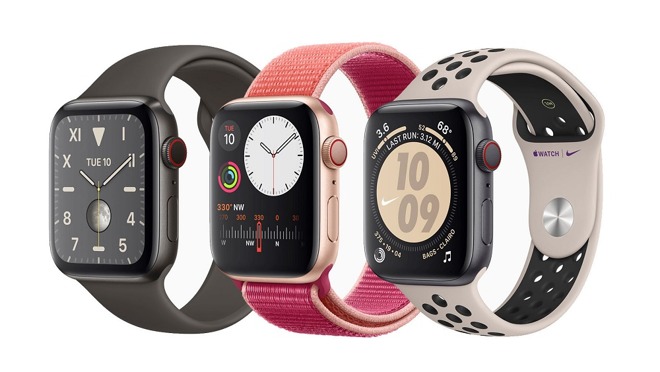
Apple Watch sold an experience that beat lower-priced smartwatches
It was Jobs’ Apple that created the rule that consumer hardware needed a major, flashy update every year—starting with iPod and continuing with iPhone and iPad. If anyone can afford to break that rule, it’s also Apple, if only because the company is so far ahead in terms of its ability to generate profits and retain its customers, even with premium pricing. And yet there isn’t any sign that Apple plans to do so.
In the minds of many tech media personalities, Apple is competing against Huawei, Samsung, Pixel, and Surface. But in reality, Apple is largely competing against what it shipped last year.
All of the facts we have pointed to the reality that Android makers are competing for sales against each other, while Apple is largely servicing its own base of users, with only a relatively minor influx of new Android converts and an even lower number of iOS users defecting away to try alternatives. At the same time, iPad, Apple Watch and AirPods are indeed reaching new customers and pulling them into the Walled Garden. We know this because of the high numbers of buyers new to Apple’s platforms.
Apple’s installed base of users continues to grow significantly. And because those consumers joined for the experience rather than being attracted by cheap pricing, they’re much less likely to leave just because a competitor offers a low price. Huawei, Samsung, Pixel, and Surface are finding that its extremely difficult and expensive to consistently deliver a very attractive, desirable overall experience.
That again tells us that Apple’s toughest competitor will be the strength of its existing products. Face with tight economic circumstances, users with an iPhone X might choose to stick with the experience they have rather than paying for an upgrade to Apple’s latest iPhone 12. But that’s a deferred purchase, not a sale lost to a competitor that might never return.
Among Android licensees, the fight isn’t just to get users to upgrade, but also to prevent them from going with another cheaper Android maker capable of delivering the same basic experience. That’s cutthroat, and in a world where economic conditions are much worse, it will be a bloodbath for Android makers to flood out cheap new devices in the massive volumes needed to break even.
These companies were already barely making any money during the economic boom. They have no margin to relax.
What happens in 2020?
Rather than being hopelessly weak in terms of competitive pricing and precariously in danger as media critics have preached for years, Apple has been focused on building a solid launch site for its future premium experiences within the Walled Garden. Now that things have been turned upside down by an unanticipated pandemic, Apple’s forward-thinking ecosystem built for its solid installed base of users is enabling it to react to very difficult conditions from a position of strength that its peers lack.
Rather than retracting into hibernation, Apple’s ambitions continue to run full throttle despite the current situation. Instead of canceling its developer conference as Google did with I/O, Apple announced that WWDC20 will simply adapt, enabling it to continue to advance its latest technology and help its developers continue to support it regardless of the complications posed under the new normal of a global pandemic.
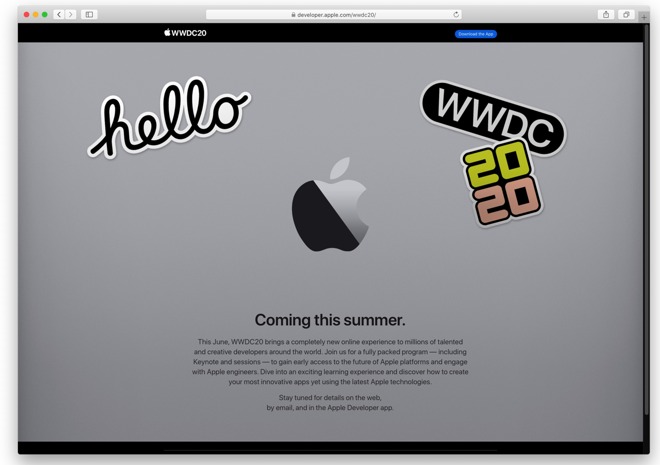
“This June, WWDC20 brings a completely new online experience to millions of talented and creative developers around the world”
A core reason for that is that Apple’s platforms define the premium experience that users pay for. Google’s work on Android is merely the least it can do to maintain volume shipments of cheap devices it can use to present advertising and collect analytics from.
The Android experience can tread water without losing sales because Android’s customers are attracted to its extremely low price points regardless of its flaws.
Over the long term, that difference in platform investment will have a significant impact. Google previously “took a year off” a decade ago when it sidelined work on Android 2.0 phones to concentrate on Android Honeycomb 3.0, which was exclusively aimed at delivering tablets that could compete with iPad. Google not only failed in that respect but also squandered a year of Android phone development that allowed Apple more time to refine its iOS experience to compete against the rest of the world’s hardware makers, which by 2010 were largely lining up behind Android.
Apple is vastly better positioned today, so any complacent relaxing or distraction in Androidland will have an even greater impact on the difference in experience Apple can deliver. Looking at tablets, smartwatches, and even earbuds, it’s pretty clear that Android is already struggling to deliver just the status quo.
Apple is pretty clearly planning for a future leap in AR and wearables that Android partners will have an extremely difficult time matching even with the full attention of Google. Any loss in interest or diversion of resources toward ads or Chrome or health initiatives or robots whatever else Alphabet plans to do will be disastrous for the future of Android.
Imagine the situation Apple would be in today if it had squandered its cash pile to frantically buy up huge acquisitions it hoped could allow it to catch up in chat, video sharing, social networking, or other areas that all turned out to be worth a lot less than having more than $100 billion to spend just as the global economy crashed under the weight of a pandemic.
That’s effectively what Google and Facebook have done, under the assumption that advertising would never run into any problems. Now consider how easy it will be for those two massive ad networks to sustain their vast tentacles of moonshots and experiments while ad revenues continue to dry up as the world takes a deep breath.
A report by Variety recently noted that “ad spending is falling off a cliff amid the COVID-19 pandemic,” and that Facebook and Google are estimated to see lost ad revenues of $44 billion just this year. While consumers stuck at home tend to be using various services more, Facebook noted in a blog posting last week that “we don’t monetize many of the services where we’re seeing increased engagement.”
Contrast that with Apple’s Walled Garden, where a significant bump in App Store sales and adoption of new Services from those billion pockets in quarantine is contributing directly to higher-margin revenues. Once the current situation improves, the deferred hardware purchases that Apple will likely suffer through this year will bounce back with a surge of replacements and upgrades. That can’t be said of ad spending.
In the next segment, we’ll take an expanded look at what Apple has been doing since the crisis struck, and what this tells us about Apple and its ability to survive and maintain its innovation trajectory despite extremely difficult circumstances.
